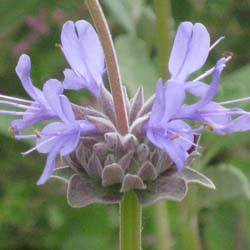Ask Mr. Sage: Best Time to Plant Drought Resistant CA Natives

Dear Mr. Sage,
I've noticed that many of the drought tolerant plants California cities recommend are native species. But I haven't had a lot of luck with them in my garden. I live in Riverside in Southern California. One plant I'd like to grow that our city suggests is Cleveland Sage. I enjoy the way it smells and the lavender flowers. Unfortunately, mine died weeks after I planted it in mid-June. I want to try again. What can I do to help it survive?
Sincerely,
Perplexed Native Gardener
Dear Perplexed,
Fall is the best season for planting many California native perennials, so the timing of your question is excellent.
Growing conditions in fall are better for planting many perennials in our state. While the soil remains warm, air temperatures are cooling and, thus, decreasing moisture loss due to evaporation. Also, garden pests are entering dormancy, so plants don't have to expend as much energy fighting predation. All of this adds up to strong roots that give plants a head start on their main work in spring -- growth of foliage.
No matter how drought resistant a plant is, it needs regular moisture to survive when first planted. Of course, drought restrictions can make it difficult to water sufficiently during extremely hot summer weather. But in our Mediterranean-type climate of dry summers and wet winters, fall planting ensures more precipitation and less need for watering.
By spring, a native perennial may be so well established that it won't need any supplemental watering to survive. For native sages, overwatering is more of a problem than under-watering once established.
Other growing conditions to consider at any time of year include sun exposure and soil drainage. Cleveland Sage (Salvia clevelandii) needs a full sun location. Make sure your soil is amended with plenty of organic matter for sharp drainage. Adding gravel is a good idea as well if you don't already have coarse soil. Slopes and berms also aid drainage.
Here is a list of our California native sages, including Bee's Bliss Sage (Salvia x 'Bee's Bliss'), Hummingbird Sage (S. spathacea) and White Sage (S. apiana). Please contact us for more advice about drought-tolerant sages and California native plants landscaping. We'll help you succeed at waterwise native gardening.
Thanks for your question,
Mr. Sage

 Salvia x 'Bee's Bliss'
Salvia x 'Bee's Bliss'  Salvia spathacea
Salvia spathacea  Salvia mellifera 'Terra Seca'
Salvia mellifera 'Terra Seca'  Salvia clevelandii 'Winnifred Gilman'
Salvia clevelandii 'Winnifred Gilman'
Comments
There are no comments yet.